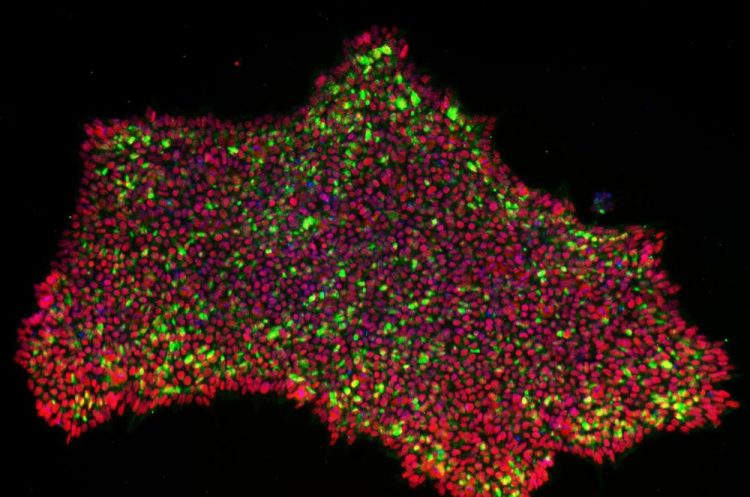Researchers develop a new method for turning skin cells into pluripotent stem cells

CRISPRa reprogrammed induced pluripotent stem cell colonies stained for pluripotency marker expression. Credit: Otonkoski Lab / University of Helsinki
Up till now, reprogramming has only been possible by introducing the critical genes for the conversion, called Yamanaka factors, artificially into skin cells where they are not normally active at all.
Professor Timo Otonkoski at the University of Helsinki and Professor Juha Kere at Karolinska Institutet and King's College London, with their teams of researchers, have now for the first time succeeded in converting skin cells into pluripotent stem cells by activating the cell's own genes.
This was achieved by using gene editing technology – called CRISPRa – that can be directed to activate genes. The method utilizes a blunted version of the Cas9 'gene scissors' that does not cut DNA and can therefore be used to activate gene expression without mutating the genome.
“CRISPR/Cas9 can be used to activate genes. This is an attractive possibility for cellular reprogramming because multiple genes can be targeted at the same time. Reprogramming based on activation of endogenous genes rather than overexpression of transgenes is also theoretically a more physiological way of controlling cell fate and may result in more normal cells.
In this study, we show that it is possible to engineer a CRISPR activator system that allows robust reprogramming of iPSC”, tells Professor Otonkoski.
An important key for the success was also activating a critical genetic element that was earlier found to regulate the earliest steps of human embryo development after fertilization. “Using this technology, pluripotent stem cells were obtained that resembled very closely typical early embryonal cells”, Professor Kere says.
The discovery also suggests that it might be possible to improve many other reprogramming tasks by addressing genetic elements typical of the intended target cell type.
“The technology may find practical use in bio banking and many other tissue technology applications”, says PhD student, MSc Jere Weltner, the first author of the article published in Nature Communications. “In addition, the study opens up new insights into the mechanisms controlling early embryonic gene activation.”
Media Contact
All latest news from the category: Life Sciences and Chemistry
Articles and reports from the Life Sciences and chemistry area deal with applied and basic research into modern biology, chemistry and human medicine.
Valuable information can be found on a range of life sciences fields including bacteriology, biochemistry, bionics, bioinformatics, biophysics, biotechnology, genetics, geobotany, human biology, marine biology, microbiology, molecular biology, cellular biology, zoology, bioinorganic chemistry, microchemistry and environmental chemistry.
Newest articles

Sea slugs inspire highly stretchable biomedical sensor
USC Viterbi School of Engineering researcher Hangbo Zhao presents findings on highly stretchable and customizable microneedles for application in fields including neuroscience, tissue engineering, and wearable bioelectronics. The revolution in…

Twisting and binding matter waves with photons in a cavity
Precisely measuring the energy states of individual atoms has been a historical challenge for physicists due to atomic recoil. When an atom interacts with a photon, the atom “recoils” in…

Nanotubes, nanoparticles, and antibodies detect tiny amounts of fentanyl
New sensor is six orders of magnitude more sensitive than the next best thing. A research team at Pitt led by Alexander Star, a chemistry professor in the Kenneth P. Dietrich…





















